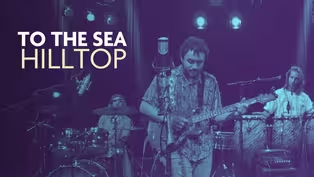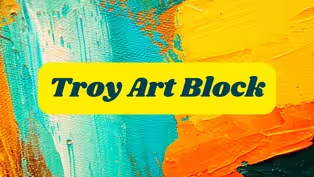
Nervous System Studio Bridges Art, Science, and Tech
Clip: Season 9 Episode 12 | 6m 16sVideo has Closed Captions
Discover Nervous System, where art, science, and technology converge to create 3D designs.
Step into Nervous System, where art, science, and tech combine. Explore 3D designs, jewelry, organ networks, and more inspired by nature's patterns. Curiosity and creativity redefine limits.
Problems playing video? | Closed Captioning Feedback
Problems playing video? | Closed Captioning Feedback
AHA! A House for Arts is a local public television program presented by WMHT
Support provided by the New York State Council on the Arts (NYSCA), M&T Bank, the Leo Cox Beach Philanthropic Foundation, and is also provided by contributors to the WMHT Venture...

Nervous System Studio Bridges Art, Science, and Tech
Clip: Season 9 Episode 12 | 6m 16sVideo has Closed Captions
Step into Nervous System, where art, science, and tech combine. Explore 3D designs, jewelry, organ networks, and more inspired by nature's patterns. Curiosity and creativity redefine limits.
Problems playing video? | Closed Captioning Feedback
How to Watch AHA! A House for Arts
AHA! A House for Arts is available to stream on pbs.org and the free PBS App, available on iPhone, Apple TV, Android TV, Android smartphones, Amazon Fire TV, Amazon Fire Tablet, Roku, Samsung Smart TV, and Vizio.
Providing Support for PBS.org
Learn Moreabout PBS online sponsorship(bright music) - Nervous System is a design studio that works at the intersection of art, science and technology.
Our work is very inspired by how nature creates patterns.
So we look at a lot of the science and mathematics behind how patterns are formed in nature, like how does coral grow, how do veins form in leaves?
And then we use those mathematical algorithms to grow products and artworks.
- I'd say our medium is really more code and software than any material.
We create systems that can create a myriad of unending forms.
- So everything that we make, whether it's 120 foot tall sculpture, or a microscopic 3D printed organ, is based on code that we write.
(gentle music) If you look at a tree outside, every leaf on that tree is different.
They're generated by the same growth process, but there's a variety to the forms where every one comes out unique.
We wanna have that same type of variety in our work.
Let's say we're making a jigsaw puzzle.
Every single jigsaw puzzle that we make is different, to have the different image, a different set of pieces to it.
For our work on leaf venation specifically, we read a lot of scientific papers about how do veins form in leaves, and there's normally not a clear cut answer.
So there's a lot of scientists who have theories, and they've written up those theories, and then we sort through the research, and find one that may be a good tool for us to use in design.
So we found a specific paper written by a guy named Adam Runions, that was built on a theory called auxin flux canalization, and he had a rudimentary algorithm already written out.
So we adapted that, and created our own software based on that, and that allowed us to use it for design.
We used it to grow a collection of 3D printed lamps.
Each one is unique like leaves on a tree.
And then also we have a jewelry collection that's based on the same thing.
(bright music) There are certain projects that our studio is very known for, one of which is a 3D printed dress.
Our kinematics dress project is a project that's all about thinking about new ways to make custom fit clothing.
So it's a completely 3D printed garment, that comes outta the machine ready to wear, which is made from a 3D scan of your body, and co-designed by you.
So it's a project where we're working with new fabrication methods.
We're working with software that allows you to design clothing in 3D.
- And then you're designing something which is much bigger than your typical 3D printer.
So one of the cornerstones of the project is we design this garment in 3D, and then we digitally fold it into a smaller configuration that fits inside the printer, and then it comes out in one single piece, just unfolds and is ready to wear with no assembly.
(bright music) We collaborated with scientists at Rice University working on creating 3D printed organs, structures that are smaller than a dime.
We collaborate with them designing vascular systems so... - Blood vessel networks basically, but also air networks.
One of the organs that we worked on the longest is the lung.
So in the lung, you have networks for air, and network works for blood that are interpenetrating and work together, to oxygenate blood.
So the project was pretty fun to work on, just because it's really interesting.
Our work is very inspired, as we said, by how patterns emerge in nature, and specifically in biological systems.
So it's really neat to be able to take our algorithms and put them back into biology, and see structures that we generated, and grew actually have blood pumping through them, and being used in a scientific study.
A photo of the structure we designed appeared on the cover of "Science" magazine, which is a huge milestone for us, to have our work as designers recognized also in the scientific world.
- This research is also very long term.
There's so many steps, and it's many, many years of research ahead, before putting 3D printed organs in a person is a real thing.
(bright music) A recent project that we did, was creating a sculpture that is currently at the Albany airport.
- It's called "Corollaria Gyroid," and it's based on a mathematical surface called the gyroid, which was discovered by a guy named Alan Schoen at NASA in the 1970s.
When Alan discovered it, he first thought it was purely just a mathematical, abstract idea that he had come up with, but later they discovered that it actually occurs in nature, inside of butterfly wig scales.
- We had the opportunity to meet Alan Schoen last year, which was really great, and we made a version of this sculpture in wood for his university.
That evolved into this latest piece, which is the evolution of that sculpture.
And rather than making it in wood, we're making it in a much more permanent, durable material of aluminum.
(gentle music) - People frequently ask us, where do we see Nervous System going?
"What are you gonna be doing in 10 years?"
And the answer is, we have absolutely no idea.
That isn't the way we operate the studio.
We just go where our interest takes us, and we get certain opportunities and we follow those.
- We just do what we do, which I guess is art.
It's really just about exploring ideas that excite us.
(gentle music)
Hilltop's 'Sunshine' Live Performance
Video has Closed Captions
Clip: S9 Ep12 | 3m 56s | Hilltop performs their song "Sunshine" live. (3m 56s)
Hilltop's 'To the Sea' Live Performance
Video has Closed Captions
Clip: S9 Ep12 | 4m 17s | Hilltop performs their hit "To the Sea" live. (4m 17s)
Troy Art Block Transforms City Into An Open-Air Gallery
Video has Closed Captions
Clip: S9 Ep12 | 11m 1s | Discover Troy Art Block's captivating public art transformation. (11m 1s)
Providing Support for PBS.org
Learn Moreabout PBS online sponsorshipSupport for PBS provided by:
AHA! A House for Arts is a local public television program presented by WMHT
Support provided by the New York State Council on the Arts (NYSCA), M&T Bank, the Leo Cox Beach Philanthropic Foundation, and is also provided by contributors to the WMHT Venture...


















